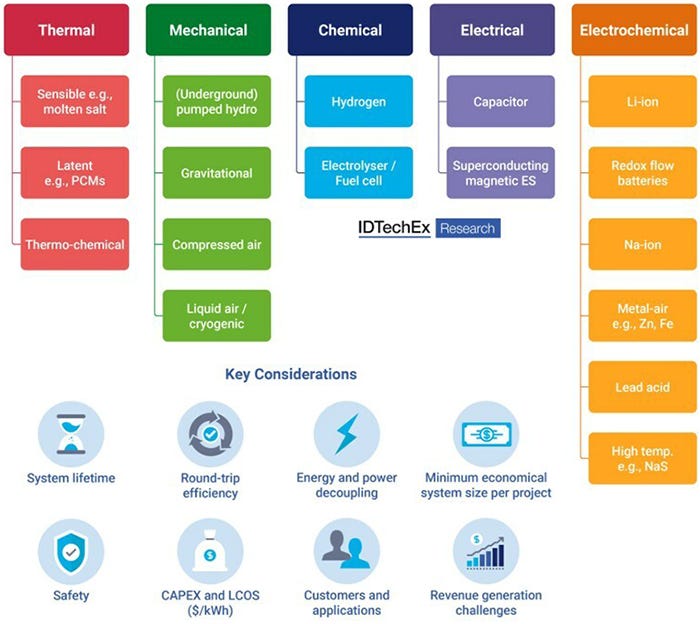Long Duration Energy Storage: A Renewable Grid Solution
IDTechEx reveals projections for long-duration energy storage and addresses renewable grid challenges.

The rapid growth of variable renewable energy (VRE) sources in global electricity grids requires effective management of supply uncertainty and variability. Long duration energy storage (LDES) technologies emerge as critical solutions to support grids with high penetrations of VRE, particularly from the 2030s onward. According to IDTechEx's latest market report, “Long Duration Energy Storage Market 2024-2044: Technologies, Players, Forecasts,” global installations of LDES are projected to reach 1.4 TWh by 2044.
A diverse range of LDES technologies, including electrochemical, mechanical, thermal, and hydrogen storage, are currently under development and commercialization across key regions. These technologies benefit from substantial investments and offer potential cost advantages over traditional lithium-ion batteries on a $/kWh basis.
The potential of mechanical energy storage systems
Mechanical energy storage systems, encompassing technologies like redox flow batteries, liquid-air, compressed-air, and underground pumped hydro storage, are anticipated to contribute significantly to LDES deployments. IDTechEx stated,“ The independent scaling of energy capacity would see systems such as redox flow batteries (RFB), liquid-air, compressed-air, and underground pumped hydro storage, and some zinc battery designs benefit from reduced CAPEX (on a $/kWh basis) at longer durations of storage.”
Emerging technologies and market trends
Several emerging technologies, such as iron-air batteries, rechargeable zinc batteries, redox flow batteries, and thermal energy storage, are projected to gain traction in the LDES market. However, their lower round-trip efficiencies compared to lithium-ion batteries pose challenges.

Energy Storage Classifications. Credit: IDTechEx
Lower round-trip efficiencies mean that a higher proportion of the energy stored in these LDES systems is lost during the charging and discharging processes compared to lithium-ion batteries. As a result, these technologies may experience higher energy losses, reducing the overall effectiveness of energy storage solutions. Systems with higher efficiencies, such as lithium-ion batteries, may be preferred for applications requiring rapid response times or frequent charge-discharge cycles, where minimizing energy losses is essential.
The role of thermal energy storage (TES)
Thermal energy storage (TES), primarily used in industrial processes, is expected to contribute to decarbonization efforts by supplying heat. Although less likely to be deployed for electricity storage at scale, TES could improve the efficiency of certain LDES technologies.
IDTechEx explains in their report that “a growing proportion of TES systems are likely to be used more so by industrial companies to decarbonize their heat production processes, which have traditionally relied on burning natural gas. This will help minimize any penalties for releasing GHG emissions above a given cap.”
Barriers to deployment and outlook
Widespread deployment of LDES technologies faces barriers such as the need for longer-term revenue visibility. Regulatory reforms are essential to enhance the economic viability of LDES technologies and instill confidence among investors. As LDES systems are mostly going to be 100 MWh-to-GWh-scale systems, their value could be in the range of US$100M-1B+. Despite challenges, IDETechEx is confident that the demand for LDES is expected to accelerate in key regions by the mid-2030s, with global demand increasing by around 2040, contingent upon VRE penetration levels.
About the Author(s)
You May Also Like





